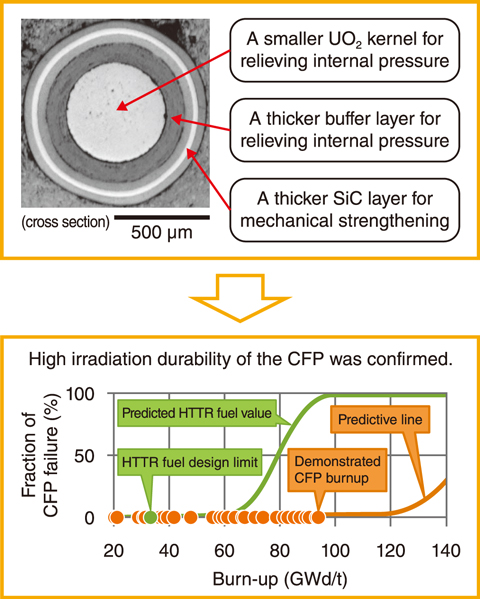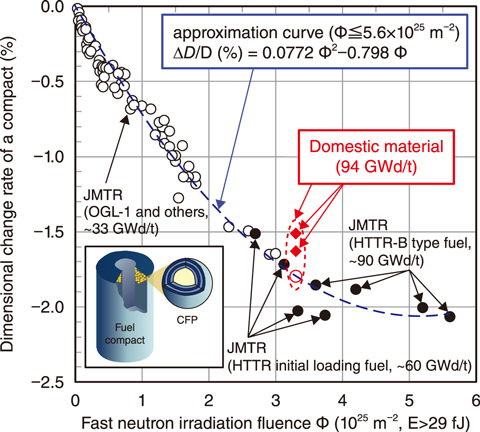
Fig.6-4 Features of the high-burnup CFP design and its neutron irradiation test result

Fig.6-5 Experimental relationship between the dimensional change rate of the fuel compact as a function of the fast neutron fluence
High temperature gas-cooled reactor (HTGR) has attracted attention as one of small modular reactors. To reduce the costs associated with achieving the economic goals of HTGR, its fuel performance should be improved to increase safely the amount of energy extracted from uranium fission. The conventional fuel used for the High Temperature Engineering Test Reactor (HTTR), the 30-MWt helium-cooled HTGR in Japan, is designed to burn up to 33 GWd/t in maximum.
A coated fuel particle (CFP) contains an UO2 kernel wrapped in four successive and thin ceramics, including, from the innermost to the outermost layer, a low-dense pyrolytic carbon (PyC) as a buffer, a high-dense PyC, a silicon carbide (SiC) and a high-dense PyC. These so-called “coating layers” confine the fission product (FP) released from the UO2 kernel burned during operation. The coating layers could be failed by excess high pressure inside the CFP due to the gaseous FPs and carbon monoxide generated by uranium fission when the burnup exceeds the design limit of the CFP.
In this study, therefore, a CFP was developed corresponding to a burnup extension. To improve retention of gas components, the newly-designed particle, shown in Fig.6-4, features a smaller diameter of the fuel kernel and thicker layers for the buffer and the SiC coatings. The new CFP was manufactured using existing mass production technology by Japanese HTGR fuel maker, Nuclear Fuel Industries, Ltd. In this process, CFPs approximately 1 mm in diameter are poured into a molding die together with a base material consisting of graphite powders and phenol resin binder, and then calcinated and solidified to form a cylindrical fuel compact. Since the development of the HTTR, procurement of this base material has relied on imports. For practical use of Japanese HTGR fuel, it is necessary to develop new domestic base materials having similar properties under neutron irradiation to the conventional. In this study, the fuel compact using newly-developed domestic was fabricated and confirmed its integrity. And then, a neutron irradiation test with new fuel compact samples up to 94 GWd/t of burnup was performed in the WWR-K irradiation reactor in the Institute of Nuclear Physics in Kazakhstan under international cooperation. As the result, it was indicated that the dimensional change rate of the fuel compact made of domestic base material was comparable to that made of the conventional imported material (Fig.6-5). The dimensional change of the fuel compact due to neutron irradiation significantly affects the heat removal performance of the fuel rod, which limit the burnup and lifetime of the fuel.
Thus, both integrity of the new CFP for higher burnup than that of the HTTR and applicability of the new domestic base material for the fuel compact were successfully demonstrated at a 100 GWd/t burnup range of the practical HTGR. Furthermore, these results show the capabilities of the HTGR fuel design by JAEA and the mass production technology by Nuclear Fuel Industries, Ltd. are among the world’s leaders.
Future work will focus on advanced technologies upgrading performance and economy of the HTGR fuel, such as, by increasing the packing fraction of CFPs in a fuel compact to extend fuel lifetime and by coating an additional zirconium carbide layer as an oxygen getter material to prevent from failure of the CFP due to its internal gas pressure.
(Koei Sasaki)